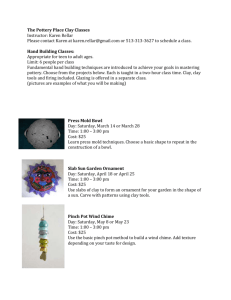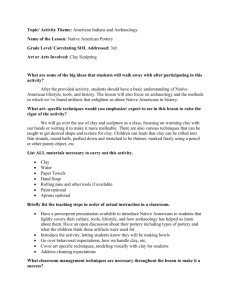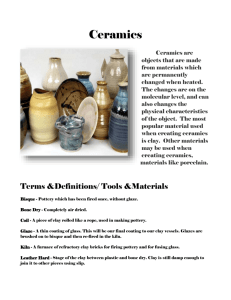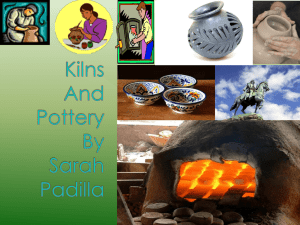this lesson plan as a Word Document
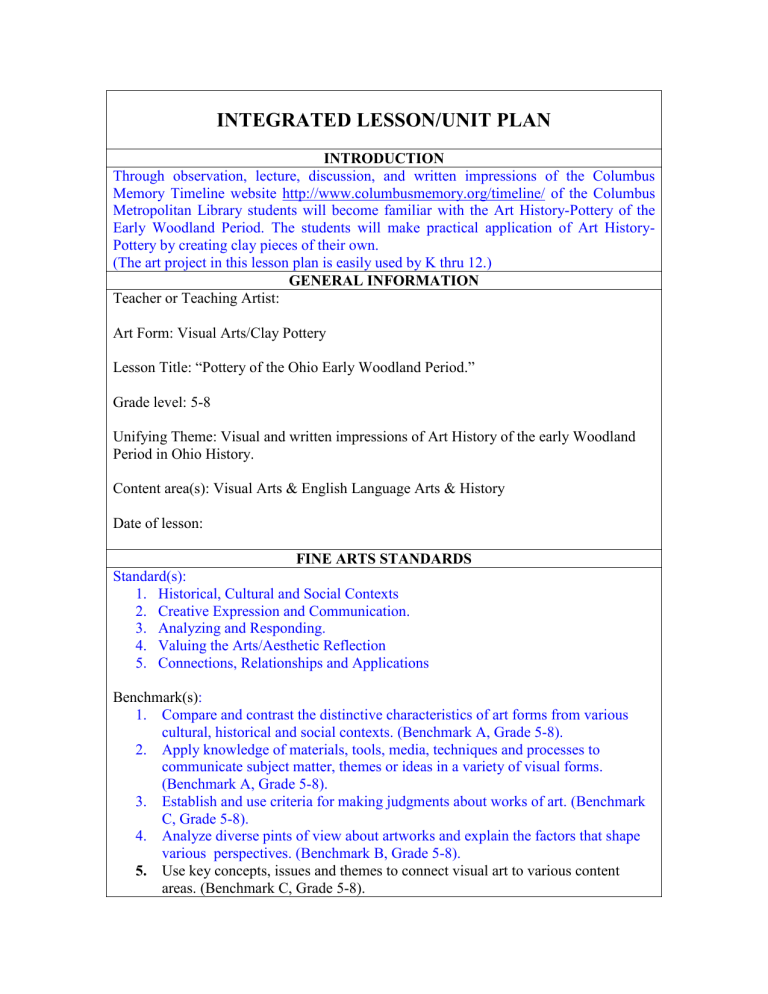
INTEGRATED LESSON/UNIT PLAN
INTRODUCTION
Through observation, lecture, discussion, and written impressions of the Columbus
Memory Timeline website http://www.columbusmemory.org/timeline/ of the Columbus
Metropolitan Library students will become familiar with the Art History-Pottery of the
Early Woodland Period. The students will make practical application of Art History-
Pottery by creating clay pieces of their own.
(The art project in this lesson plan is easily used by K thru 12.)
GENERAL INFORMATION
Teacher or Teaching Artist:
Art Form: Visual Arts/Clay Pottery
Lesson Title: “Pottery of the Ohio Early Woodland Period.”
Grade level: 5-8
Unifying Theme: Visual and written impressions of Art History of the early Woodland
Period in Ohio History.
Content area(s): Visual Arts & English Language Arts & History
Date of lesson:
FINE ARTS STANDARDS
Standard(s):
1.
Historical, Cultural and Social Contexts
2.
Creative Expression and Communication.
3.
Analyzing and Responding.
4.
Valuing the Arts/Aesthetic Reflection
5.
Connections, Relationships and Applications
Benchmark(s) :
1.
Compare and contrast the distinctive characteristics of art forms from various cultural, historical and social contexts. (Benchmark A, Grade 5-8).
2.
Apply knowledge of materials, tools, media, techniques and processes to communicate subject matter, themes or ideas in a variety of visual forms.
(Benchmark A, Grade 5-8).
3.
Establish and use criteria for making judgments about works of art. (Benchmark
C, Grade 5-8).
4.
Analyze diverse pints of view about artworks and explain the factors that shape various perspectives. (Benchmark B, Grade 5-8).
5.
Use key concepts, issues and themes to connect visual art to various content areas. (Benchmark C, Grade 5-8).
GLIs (Grade Level Indicators):
1.
Discuss the role and function of art objects (e.g., furniture, tableware, jewelry and pottery) within cultures. (Grade 8-2)
2.
Apply the principles of design to construct a three-dimensional piece of artwork.(Grade 8-2)
3.
Analyze and discuss qualities in the artwork of peers to better understand the qualities in their own artworks). (Grade 8-4)
4.
Descibe how culture, age gender and attitude can affect a person’s viewpoint on the response to visual art. (Grade 6-3)
5.
Demonstrate understanding of the relationship between words and images by applying text to images and images to text. (Grade 7-3)
ENGLISH LANGUAGE ARTS STANDARDS
Standard(s): Communication: Oral and Visual
Benchmark(s) : Listening and Viewing
GLIs (Grade Level Indicators): Interpret the main idea and draw conclusions from oral presentations and visual media.
SOCIAL STUDIES STANDARDS
Standard(s): People in Societies
Benchmark(s) : Students use knowledge of perspectives, practices and products of cultural, ethnic and social groups to analyze the impact of their commonality and diversity within local, national, regional and global settings.
GLIs: (6-8, A) Compare cultural practices, products and perspectives of past civilizations in order to understand commonality and diversity of cultures.
ASSESSMENT
SUMMATIVE ASSESSMENT:
1.
Students will have a studio experience where they will experiment with and explore clay material, techniques and tools in the process of pottery making.
2.
Through discussion and written compositions of prose or poetry the students will describe their view of the Woodland people and clay pottery.
3.
Students will analyze and describe different visual aspects of their own clay pottery with that of the Early Woodland People and fellow students.
4.
Students create a written reflection (poetry or prose) on a single clay piece.
PRE-ASSESSMENT
_______________________________________________________________________
Participants will use Quick writes to integrate writing with previous knowledge about making clay pottery and the history of Ohio’s Early Woodland Period
.
_____________________________________________________________________
PROCEDURES
1. Roll of the teacher or teaching artist: Share information with students from the
Columbus Memory timeline and other sources on the
Early Woodland Period. Showing examples of pottery by the Mound Builders and the Adena pipe in human form and working with clay.
2. Time needed: 3 hours
3. Space needed: An art room or room with tables for working with clay.
4. Equipment, resources and materials needed: Tables & coverings, clay, variety of tools for decorating the clay pieces, paper & pencils.
5.Step by step: (include evidence of integration)
The teacher or teaching artist will guide the students through a Quick Write experience regarding their knowledge of making clay pottery and Ohio history of the Early
Woodland Period.
The teacher or TA will then share pictures of clay pottery and history of Ohio’s Early
Woodland Period.
In small groups students will share their impressions of the artwork and environments they viewed.
Individually students will have a hands-on experience working in clay. They will also produce a written text, either prose or poetry about their clay piece and the woodland people.
Studio Steps:
1.
Students will review a brief history of Ohio’s Early Woodland Period and discuss the materials/tools used in making clay pottery, adding terms to their quick write.
2.
Students will draw a rough sketch of the clay piece they plan to make.
3.
Students will edit and transpose their sketch into clay.
4.
In small groups the students will describe and analyze different visual aspects of their work.
5.
The students will briefly write (in poetry or prose) about their clay pieces and the
Woodland people.
6.
The students will view each others clay pieces and compositions.
7.
Students will reflect on the finished pieces and compositions.
CONNECTIONS
1. Enrichment/Intervention Resources:
Places to visit:
Shrum Mound, Columbus, Ohio at Mckinley Ave.
Ohio Historical Society, Columbus, Ohio
Mound Builders Park, Newark, Ohio
2. Technology: http://www.columbusmemory.org/timeline/
Connections to History: http://www.touring-ohio.com/history/ancient-ohio.html
http://www.bulingtonenews.net/ohogiants.html
http://www.cyahogafallshistory.com/oounds_builders.httm
http://www.karenswhimsy.com/mound-builders.shtm
Connections for working with clay: http://www.nativetech.org/pottery/making.htm
http://www.ehow.com/way_5491452_making-native-american-pottery.html
http://www.pottery-magic.com/pottery/history/making_pottery.htm
3.
Other:
1. What went well?
2.
What changes should be made to make this lesson better?
3. How many students participated in this lesson? ____
4.
Approximately how many students mastered the lesson’s objectives? ____


